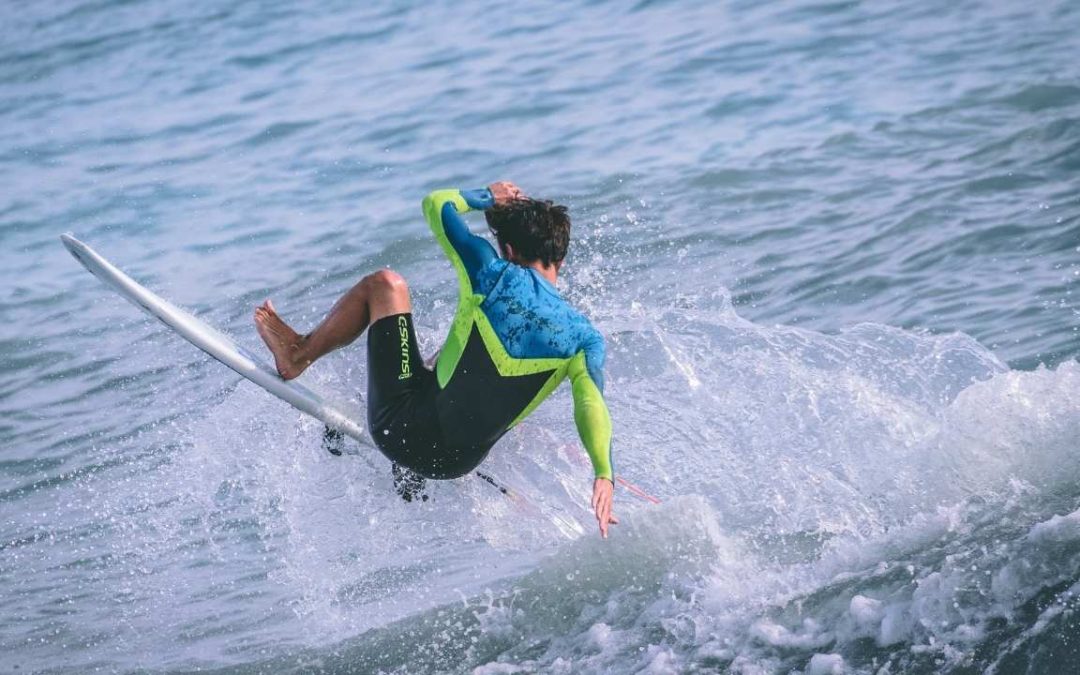Surfing is a really fun sport, but it can be dangerous. I have sliced my achilles heal, bashed my face on a reef in Bali, torn ligaments, and tweaked my back. Even with all of that, I still try and paddle out every day. But how bad can you really hurt yourself surfing?
Injuries through surfing occur when your body is out of shape physically or by contact with your surfboard, the reef, or fellow surfer. Typical injuries include ligament tears, lacerations, concussions, and in the worst circumstances, drownings. These injuries can be avoided by taking precautions.
Even with all of those possible ways to get hurt, millions of people surf across the world every day.
And you can be one of them! This post will help you identify ways you can get hurt while surfing and what you can do to prevent any injuries from happening.
Common Injuries While Surfing
Oh boy! Where do we start with some of the common injuries you can get while surfing? Itʻs funny, because the type of injury you can get tends to vary based on, length of time surfing and your age.
Iʻll try to do my best to break it all down so you can know what types of injuries to expect and how you can train to prevent them.
Common Injuries For Beginners
- Sore or Bruised Ribs
Many beginners complain about their ribs hurting after having surfed a few times. I remember mine did. It made it hard to breath and painful to lay on a surfboard.
As you paddle your surfboard, you tent to lift your head an shoulders up and push your rib cage into your surfboard. The combination of these body movements tend to create bruising in surfers who havenʻt been paddling for long.
It does go away. I remember tryin to surf through it, but ended up having to take a break to let the pain subside before trying again.
- Lacerations
Itʻs pretty common for beginners to get a cut every now and then. It can come from your surfboard, a wayward rock or a fellow surfer.
Since a lot of beginners have been using soft tops surfboards lately, it has been less likely to get a cut from your board than it was when fiberglass boards were the option.
With fiberglass boards you can ding the fiberglass on your surfboard with your body and get cut. The fiberglass fins are like knives, I remember cutting my achilles on mine running out towards the ocean.
If you surf beach breaks, you may not come across this problem, but for those who surf spots that are rocky or have reef, cuts are pretty common. I remember stepping down to push off the bottom at a reef break and I ran my foot against these clams that had shells like razor blades, giving me several deep cuts. I never did that again.
For those of you that surf crowded surf spots, watch out for those other surfers! Collisions happen. And those collisions can hurt. What normally happens is that a board hits someone, causing a cut to occur on someone.
- Back Pain
Surfing can be hard on the back. The act of laying in the prone position, paddling with an arched back, then trying to quickly pop up to your feet can take its toll on the back.
While this injury is common for older surfers, younger surfers can experience it as well, especially when just getting started with the sport.
- Rashes
I remember getting rashes all of the time when I was just learning to surf. Maybe it was from being in the water all day, or it couldʻve been from the fact that my arms needed to get used to paddling, but I would always get a rash in my armpits.
This is common for many beginner surfers as their body adjusts to riding waves in a medium made up of saltwater.
Common Injuries For Advanced Surfers
- Joint Injuries
It is common for advanced surfers to experience injuries in their knees, shoulders, and ankles. These injuries occur because of the constant twisting, compressing and stretching that occurs with more high performance surfing.
- Spinal Injuries
Spinal injuries occur more often with advanced surfers because the tend to surf more waves of consequence. These waves, often breaking in shallow water, have the tendency to break backs, leading to paralysis.
I donʻt want to say this type of injury is too common. It is quite rare actually, but it does happen. I had a friend in high school have this happen to him. He severed his spinal cord surfing before school at a local spot known to be pretty shallow.
- Concussions
Concussions are more common than spinal injuries when surfing shallow surf breaks. Spots like Pipeline or Teahupoʻo can deliver nasty wipeouts, and even nastier concussions. This has led many surfers to choose to where helmets at spots like these.
- Lacerations
Once again, lacerations are common among advanced surfers, but for different reasons. An advanced surfer tends to get cut up because they were deep in the barrel and didnʻt make it, only to be dragged along a reef.
Sure, they can cut themselves the way I did, just by running into the water, but theyʻve probably already learned that mistake already.
Common Injuries For Older Surfers
- Muscle & Ligament Tears
Old bodies just arenʻt as pliable as they once were. Muscle and ligament tears are all too common. Iʻm dealing with a torn ligament in my shoulder right now as I type just from paddling out. I didnʻt do anything out of the ordinary!
- Herniated Discs
As we get older, our bodies just arenʻt the same, this is especially true with the back. Back injuries are very common with older surfers.
I first threw out my back surfing a local spot in my early 30ʻs. I remember being unable to stand upright at all and yet I still had to make a long trek up dozens of flights of stairs to get back to my car. It was one of the worst pains I had ever experienced. 10 years on and it still flares up.
- Surferʻs Ear
Surferʻs ear is a common ailment for older surfers that have been surfing a long time, especially for those that hail from colder waters.
Over the years, as water enters the ear canal from constant surfs, the body reacts by growing a bone spur in the ear which can be very painful and make it hard to hear, leading to surgery to make it better.
One injury that can happen at any age is one caused by a shark, but luckily for us there are things we can do to minimize a close encounter with the taxman by reading this article.
How to Avoid Injuries While Surfing?
After that long list of possible injuries, its a wonder that anyone chooses to go surfing at all. But, by taking a few precautionary measures, you can surf for years, injury free.
- Prepare Your Body
The most important thing you can do to avoid many injuries while surfing is to keep your body in shape. Exercising out of the water is just as important as exercise time while surfing.
Strength conditioning, aerobic exercises and regular stretching will keep your body free from injury and allow you to perform well in the water.
To ensure you get the best physical training for surfing, you should sign up with Surf Strength Coaching, his programs are amazing!
- Booties or a Wetsuit Can Keep You Safer
Using booties or a wetsuit at a spot known to have sharp reef can help protect you from possible lacerations. Here is a link to my favorite reef bootie.
Many surfers employ this strategy at rocky surf spots or reef breaks. It may not be considered “cool”, but if you can keep yourself from getting hurt, you can spend more time surfing.
- Learn To Surf On A Soft Top
If you are worried about the possible injuries that you can get from a traditional surfboard, try using a soft top surfboard instead.
Soft top surfboards are very forgiving. They have foam decks and soft plastic fins. It is almost impossible for these boards to hurt you.
- Watch The Ocean Before Paddling Out
A lot of injuries can be avoided simply by watching the ocean for a little bit before paddling out.
Where is the reef? Does it come up more shallow in some areas and deeper in others?
How many people are out? Will they cause a problem?
Guage the conditions a bit and you will begin to notice the hazards that are on hand for any given day. Conditions can change by the minute, so just because you are familiar with a spot, it doesnʻt mean you should ever skip this step.
- Avoid Surferʻs Ear
Surferʻs ear can be easily avoid by wearing specially designed ear plugs that keep water out but can still let sound in.
This problem is most common for surferʻs in colder waters but could happen to anyone. And trust me, you donʻt want it. My friend had surferʻs ear and he was crying like a baby. He would get such ear aches at one point it was hard for him to function.
Donʻt let that be you. Get yourself a good pair of earplugs for the surf, today!
Is Surfing Dangerous?
Surfing can be THE most dangerous sport in the world.
The sport of surfing takes place within a venue unlike any other in the world. While most sports are made on man made courts or constructed lawns, the sport of surfing takes place deep within the awesomeness of Mother Nature herself: The Ocean.
The ocean is not something that we can control. When we enter the water, we are at the mercy of the see, no matter how good you are.
Now donʻt get me wrong, you can paddle out at a super mellow beach break with few others around and probably be pretty safe in the ocean. Itʻs not always death defying stuff. But that same mellow beach break on a 5ʻ swell may not be as forgiving.
It as just as important to be able to read the ocean as it is to be able to stand up on a surfboard. If you feel like the ocean is a dangerous place (which you should), try watching it for a while. Over time, secrets will be revealed to you and it will begin to look a little less scary.



